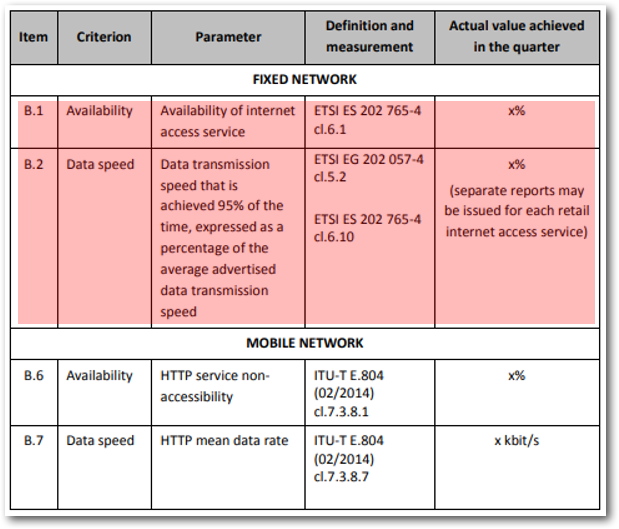On July 1st 2019, the Falkland Islands’ Communications Regulator issued a “Direction to Sure Falkland Islands, No 2019/01a Quality of Service” which requires Sure Falkland Islands to provide data on broadband Quality of Service (QoS) in the form of download speeds of the island’s broadband services using ETSI specifications.

To do justice to this important subject, I have split the post into two parts. The first part talks about the Direction and the specifications referenced., while the second part will focus on my views.
One reader jokingly (I hope!) stated that my telecommunications posts were good for helping him get to sleep at night and this one will certainly do that! If you are not of a technical bent, I would recommend skipping to the Conclusions section at the end of this post.
What is Quality of Service (QoS)?
The Wikipedia definition of QoS is as follows:
“Quality of service (QoS) is the description or measurement of the overall performance of a service, such as a telephony or computer network or a cloud computing service, particularly the performance seen by the users of the network. To quantitatively measure the quality of service, several related aspects of the network service are often considered, such as packet loss, bit rate, throughput, transmission delay, availability, jitter, etc.”
The key thought to remember is the emboldened text.
What did the Direction require Sure Falkland Islands to report?
The Direction describes the general requirements given to Sure Falkland Islands and the specific justification behind implementing a QoS programme. The most important one, to my mind, is Clause 8a.

It should be remembered that measuring and reporting performance in itself does not help improve telecommunication services. Services can only be improved if measured performance indicates where specific problems lay or throw light on operational deficiencies. Most importantly, these indicators must be identified, acted upon and rectified.
Let’s drop right into what Sure Falkland Islands are being specifically instructed to undertake. This is provided in Schedule B of the Direction as shown below:

SCHEDULE B: QoS STANDARDS FOR INTERNET ACCESS SERVICES
Requirement 8.1 specifies requires Sure to provide data on fixed-network service outages. This is the % of the time that the fixed-line broadband service is available over a quarterly period. This is a straightforward calculation. 8.6 is a similar requirement for mobile data.
It is easy to identify ‘blackouts’ as is the focus of Requirement 8.1, but a much more challenging task is the measuring and reporting of fixed-network ‘brownouts’ or slow-downs caused by congestion as should be the focus of Requirement 8.2. A brownout is a temporary reduction in the experienced download speeds caused by congestion.
Requirement 8.2 includes the following guidance:
| Data speed | This is fixed-line broadband download speed [using FTP file download]. |
| Parameter | Data Speed achieved 95% of the time, expressed as a % of the average advertised Data Speed [for each broadband package].
Note 1: There is no such thing as an ISP’s “advertised average data speed”. It should say “advertised maximum data speed” and specifically say ‘download speed’. Note 2: It should say “separate reports must be issued for each retail service” rather than “separate reports may be issued for each retail service”. It makes no sense to report the average speed of broadband packages that have different package maximum access speeds. |
| Definition | The specification referenced is ETSI ES 202 765-4 clause 6.10 and ETSI EG 202 057-4 clause 5.2. |
| Actual value achieved | Data speed is reported quarterly. |
For example, it could be imagined that this could be reported as something along the lines repeated for each broadband package:
“The average download speed for the Gold service for 95% of the time over the quarter of October 2019 to December 2019 was 2.11Mbit/s which represents 40% of the claimed access rate.”
The referenced ETSI specifications
The European Telecommunications Standards Institute (ETSI ) describe themselves as:
ETSI is a European Standards Organization (ESO). We are the recognized regional standards body dealing with telecommunications, broadcasting and other electronic communications networks and services.
ETSI is a well-recognised organisation in the traditional telecommunications world but all critical Internet standards are written and managed by the USA standards body, the Internet Engineering Task Force (IETF). However, ETSI has produced many specifications including the two referenced in the Direction:
- ETSI EG 202 057-4 Speech Processing, Transmission and Quality Aspects; Internet access.
- ETSI ES 202 765-4 Speech and multimedia Transmission Quality
What do the ETSI specifications say?
The best way to understand this is to look at the relevant clauses while trying to keep things as simple as I can for this post.
ETSI ES 202 765-4 specification
Concerning the “data transmission rate”:

Concerning the “Measurement frequency”.

Concerning the size of the “test file”.

Concerning the reporting of the “highest” data transmission rate.

Note that the DIrection does not require the lowest 5% data rate to be monitored or reported which is what mainly drives anecdotal comment about the Internet slowing down by consumers.
ETSI EG 202 057-4 specification
Three key sections address the performance of downloading and uploading of web pages and files over the Internet including:
- Section 6.9: Web page download speed – This indicator evaluates the average download performance when the customer is surfing on the Internet.
- Section 6.10: FTP download speed – This indicator evaluates the average download performance when the customer is downloading a file via FTP.
- Section 6.11: FTP upload speed – This indicator evaluates the average upload performance when the customer is uploading a file via FTP.
The Sure Falkland Islands Direction only references 6.10, FTP download speed. FTP is the adaptive protocol used for downloading files over the Internet.
There are very considerable differences in the user experience and performance of the Internet between a user browsing the web downloading files using File Transfer Protocol (FTP).
Conclusions
In a previous post – Is the reported Sure complaints data adequate for a monopoly environment?, I talked about the inadequacy and paucity of the Sure Falkland Islands Complaints procedure data that was required to be reported by Sure Falkland Islands.
Similarly, the broadband QoS Direction demands only the very barest of information with reporting limited to a set of quarterly numbers specifying “average” download speeds for the previous quarter. As it stands, with the paucity of information provided, this Directive and it’s referred-to ETSI specifications raise many more questions and concerns than it answers.
I’ll look at these sixteen questions in detail in Part 2.
Copyright: August 2019 OpenFalklands
